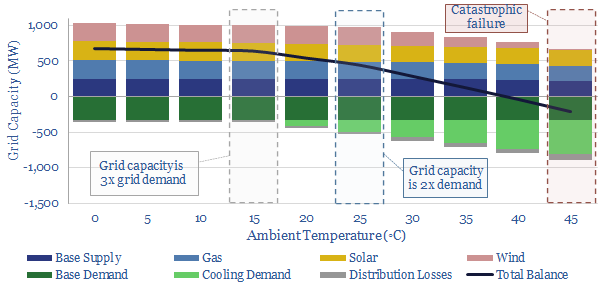Ramping renewables to 50% of power grids is a growing aspiration in the energy transition. But in some markets, it may result in devastating blackouts during summer heatwaves, as power demand doubles exactly when wind, solar, gas, transmission losses and disruptions all deteriorate. This 15-page note assesses the causes, implications and mitigation opportunities.
In David Copperfield, Charles Dickens’s quasi-autobiographical novel of 1849, Mr Micawber famously summed up his household’s finances: “Annual income twenty pounds, annual expenditure nineteen nineteen and six, result happiness. Annual income twenty pounds, annual expenditure twenty pounds ought and six, result misery”. So too with the grid. A small tilt from surplus to deficit results in blackout misery, costing billions in economic damages, and hardship for millions of people (pages 3).
High temperatures cause grid balances to deteriorate. Across every single line in our models. This is under-appreciated. It is mostly due to immutable laws of physics (which cannot be over-turned by policy-makers, try as they might). Hence our work aims to quantify these temperature sensitivities for cooling demand (page 3), wind (page 4), gas-fired power (page 5), solar power (page 6) and transmission losses (page 7).
A simple model is constructed, showing how a seemingly well-covered grid, which actually suffers from excess capacity most of the time, can thus fail catastrophically during a heatwave (page 8).
This is where power grids are heading. We outline our models and forecasts across the US, Europe, China and broader emerging markets (pages 9-10).
So what solutions exist? We fear that grids will grow more and more erratic amidst summer heatwaves. Hence we have reviewed 10 opportunities and implications, which may become interesting to investors and companies (pages 11-15).
